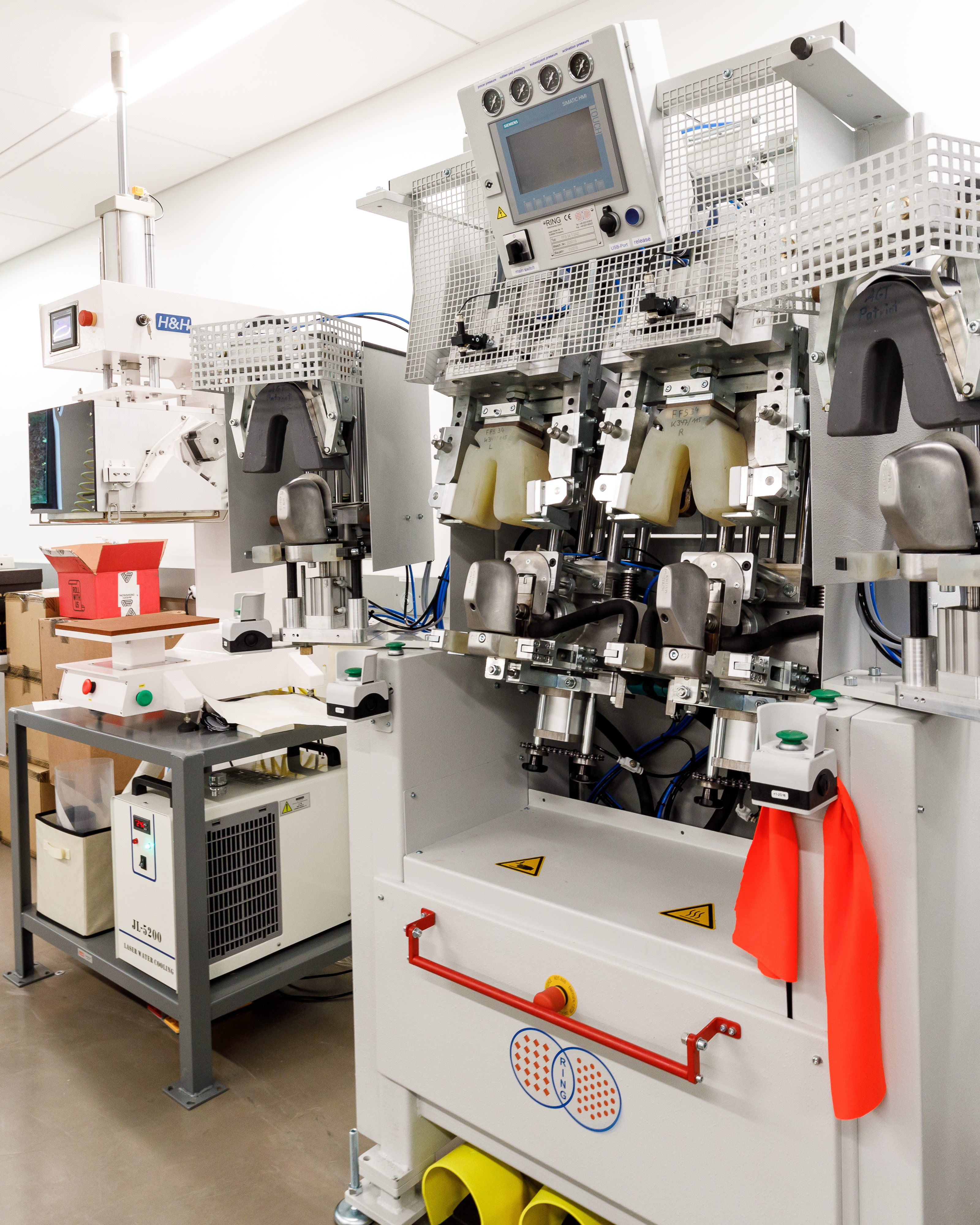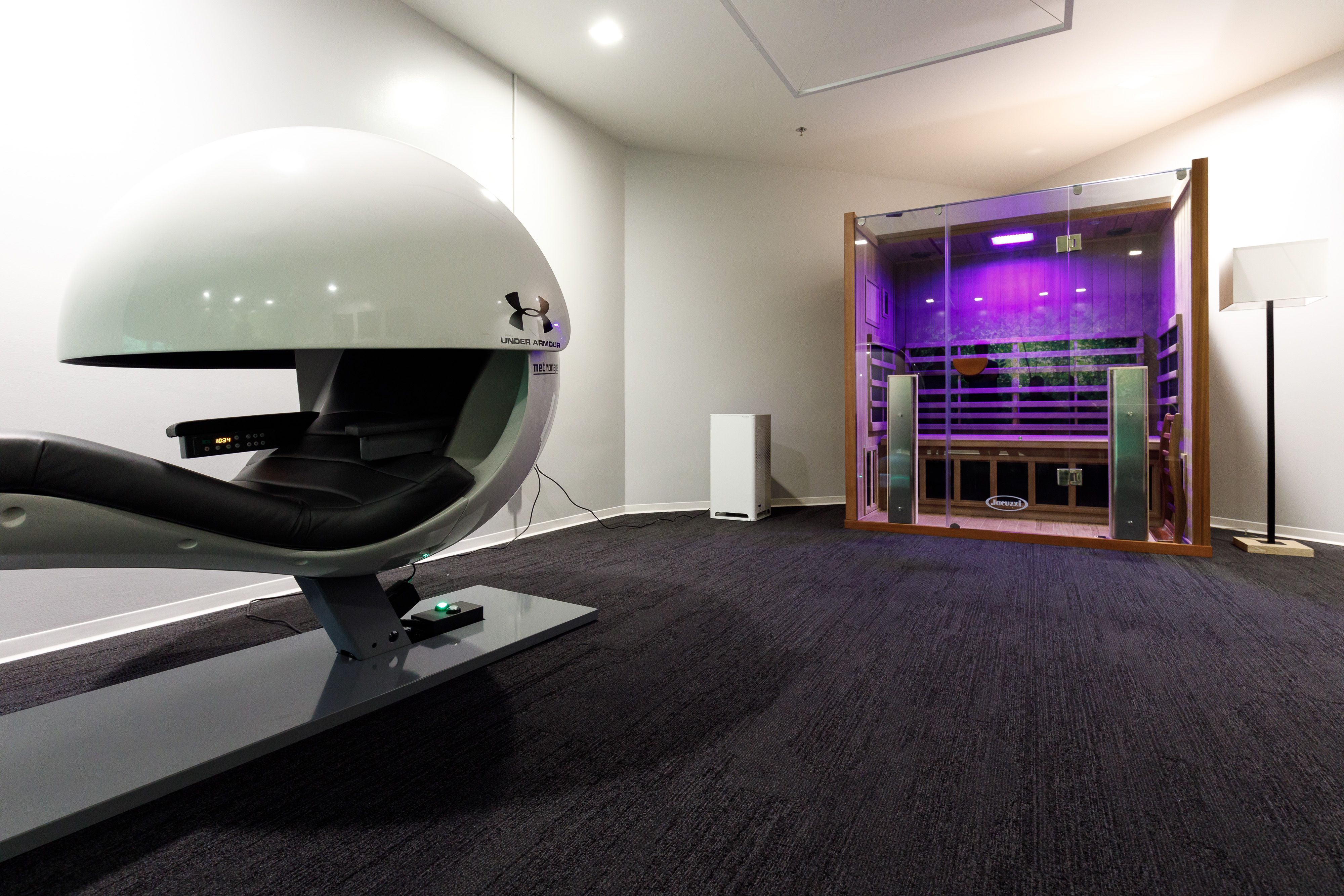feature / alumni / product-design
September 12, 2018
By Mike Winder
Photographs by Juan Posada
Going the Distance at Under Armour
Two ArtCenter alums share a history and a mission
The city of Portland, Oregon is famously home to such cultural institutions as Powell’s Books, Stumptown Coffee and the International Rose Test Garden. But when it comes to the design world, Portland is perhaps best known for being the epicenter of athletic footwear design.
The three biggest players in the industry call the City of Roses home, and each of them benefit from having an ArtCenter alum at the design helm. Martin Lotti (BS 97 Product) is Nike’s vice president of global brand design. Al Van Noy (BS 87 Product) is Adidas’ senior vice president in charge of its Future Team. And then there’s the new kid on the block, Under Armour (UA), founded in 1996 and whose presence in Portland only dates back five years. Product Design alumni Dave Dombrow (BS 00) and Kevin Fallon (BS 96) act as UA’s chief design officer and vice president of footwear innovation, respectively.
It’s a warm day in July and what seems like half of UA’s Portland employees just dispersed from the company’s cafeteria after watching France defeat Belgium in a World Cup semifinal. Dombrow, normally based in the company's Baltimore headquarters, is in town to meet with vendors. Sitting in a cozy mood board-filled office in the company’s pool room (more on that later), the two look happy to reminisce.


“I grew up loving cars, flying, Jet Skis, basically anything that burned gas and went fast,” says Minneapolis-raised Fallon, when asked about his path to ArtCenter. “But I wasn’t exposed to design in high school, so I ended up getting a degree in engineering at Brown University. But it wasn’t my passion. It only took one interview with Ford to convince me to go back to school.”
“As a kid, I was always taking things apart—electronics, BMX bikes, anything—and putting them back together,” says Dombrow, who hails from San Diego. “But, like Kevin, I didn’t know anything about design. I was planning on going into architecture, but a family friend who lived in Pasadena, right above the Rose Bowl, said I should check out this school up the hill.”
Though they go back more than 15 years—they met in the early 2000s while working at Nike—the two alums never overlapped at ArtCenter. Yet they share remarkably similar experiences. They both fell in love with the College the moment they walked into the student gallery. They both credit their tough-as-nails instructors as teaching them to take pride in their work. “I remember Joe Farrer (BS 50 Product) telling us we were responsible for what we made,” Fallon recalls. “He said we could turn in our acrylic boxes with air bubbles if we wanted, but that would reflect poorly on us and our attention to detail.”
And they both say the learned just as much about design by competing with their fellow students. “I remember Feng Zhu (BS 99 Product) smiling at me before a critique and saying, ‘I think I got you this week,’” Dombrow says of the concept artist whose work went on to appear in Transformers, Star Wars Episode III and the upcoming Alita: Battle Angel. “It was a friendly jab, and an example of the healthy competition that helped us all get better.”

Last year, Dombrow and Fallon gave a Career Chat at Hillside Campus on the importance of trust and common purpose. And a few weeks prior to our meeting, they met with ArtCenter Product Design students in Portland doing a footwear industry deep dive via the College’s Study Away PENSOLE Footwear Design Workshop. “I feel like it’s our mission to help spread the word,” says Dombrow. “Especially to kids that show an aptitude for design, because going to ArtCenter is life-changing.”
When it launched in the mid-'90s, UA differentiated itself from its competition by laser focusing on improving athletic performance—the company’s first product, designed by founder Kevin Plank, was a T-shirt made of synthetic fibers that stayed cool and dry under strenuous conditions. The shirt and strategy was a success and the company soon began attracting prominent celebrity endorsements. UA recently snagged wrestler-turned-actor Dwayne “The Rock” Johnson as an endorser—a deal that research firm Spotted cited as the strongest celebrity strategy of 2018.
“It all comes down to storytelling,” says Fallon of the importance of having a clear narrative and purpose behind your products. “I grew up in an advertising household [Ed. note: his father was Pat Fallon, founder of Minneapolis-based Fallon Advertising] and dinnertime conversations were often about commercials. What are they going for here? What are they trying to sell?”
UA’s presence in Portland itself tells a story. The Baltimore-based company had achieved success with its athletic apparel, but had ambitions to become truly competitive with its footwear. To achieve that goal, UA decided it could attract more talent by moving its footwear design division to Portland.


In 2013, the company opened a low profile office in the city’s Pearl District. Its lobby sign read simply “Thompson Dental” to throw off the competition. But in 2015, UA decided to stake its claim to the Portland scene in a major way. The company announced it planned to lease the city’s shuttered Metro Family YMCA—a state of the art facility when it opened in 1977—in Duniway Park, renovate the facility and transform it into UA PDX, the company’s footwear design and development center. And it refurbished the city’s adjacent Duniway Track to boot.
Back in UA PDX’s pool room—a space that once housed the YMCA’s pool and still features its signature skylights—Fallon speaks about the renovated space. With nearly 100 employees under its roof (and room to expand), the 70,000 square-foot facility is chock-full of high-tech equipment for recording and analyzing athletic performance and recovery, including an impressive-looking body scanner whose neon glow brings to mind Tron: Legacy.
“Being a YMCA, connected to sports, there’s a real heritage to this building,” he says, noting the site was where legendary Nike designer Tinker Hatfield first conceived of the cross trainer. “This building sat empty for a few years. Most people thought it was too much work to renovate. But we thought, ‘Wow! An indoor track? And a city park with a track right next door? It’s perfect.”


UA’s decision to open its new digs and invest more heavily in footwear talent appears to be paying off. The company’s recent second quarter results saw its footwear sales increase by 15 percent—thanks in large part to its HOVR line of running shoes it introduced earlier this year. All the shoes in the HOVR line—including the 9.6 oz HOVR Sonic, the 10.6 oz HOVR Phantom and the 8.48 oz HOVR SLK—feature a proprietary “Energy Web” cushioning system that delivers a strong responsiveness to give runners the feeling of being lifted up (“hovering”). Optional built-in sensors records a variety of metrics, including pace, cadence, stride length and distance.
“This track outside is great because we see a cross-section of people out there every day,” says Fallon. “Elementary and high school kids, the track team from Portland State, and elderly people from a retirement home right above the tracks.”
Adds Dombrow, “It’s just a great reminder for us of why we’re in this business.”
Related

profile





